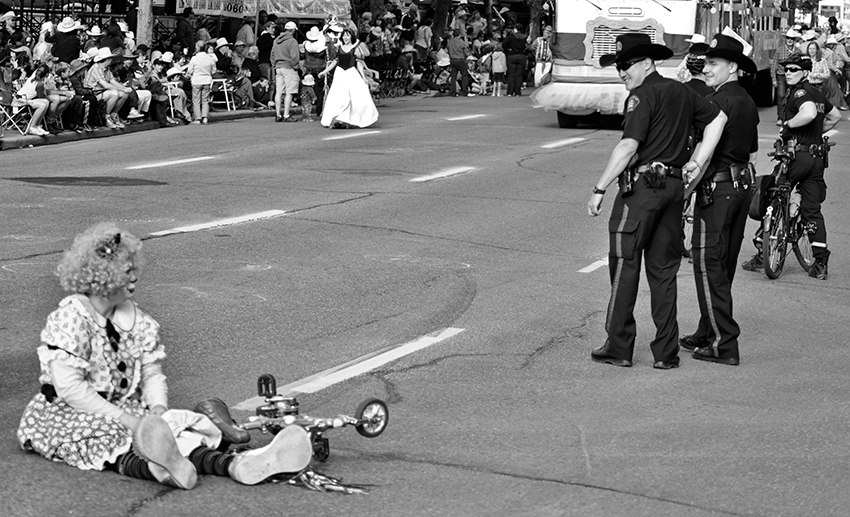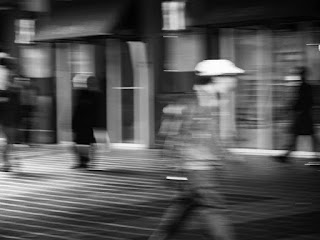
Posted on
What is Street Photography?
Often I come across individuals who like to share their photos and talk about them with me, they often use the correct terms for their photography styles as in: "landscape"; "portrait"; or even "still life"; but so often mis-use the term "Street" photography for what really is "urban" or "reportage" photography.
 |
| Calgary Tower at night |
In the same sense the following image is actually "Reportage" (photojournalism) and not street photography though people are interacting with their scene.
 |
| Anti-Islam Protesters and Counter-protesters at City Hall Calgary |
So what is "street" photography exactly if the above 2 examples are not street?
Street photography is a form of photography where the human being is interacting with their scene or are a none con-formative subject (as a paid model would be) within an urban surrounding or scene.
To show the difference, the photograph below has also many people within the scene but it is not orchestrated, has no paid models and is a random interaction between people and place in an urban environment - hence "Street" photography.
 |
| The Set-off |
 |
| The Unfell |
 |
| Arrested Rester |
 |
| Busy |
The above photo incorporates two art techniques at the same time, Hi-key photography and Selective coloring. The original idea was to pull the viewer around the photograph whilst portraying the blandness of the urban bustle. When people are rushing around they rarely see whats around them unless it stands out or is in their line of sight. Hence why the woman in red stands out because she is being avoided by another pedestrian and the woman in the greenish coat stands out because she is in the line of sight of the man in the front right. Those indicated people stand out in the scene because others are interacting with them though the urban rush around them has become irrelevant to those interacting with them in a passive way.
Though a little artistic merit has been added to the usually bland rush hour scene, by keeping the main color of the two ladies makes for a small urban story.
In the photograph below I kept an accidental photo that captures people walking around, the blur made it feel like everyone was in a rush, so that is why I kept it.
 |
| In a rush |
There is nothing wrong in being creative in street photography as long as it adds to the main visual story.
 |
| From the rooftop |
Knowing when to shoot as all the elements come into play to make that one superb photo is the key to great street photography.
 |
| Don't shoot |
 |
| A third in focus |
Black cameras or blackened cameras work best because they don't attract as much attention as silver or any other colored camera does.
Smaller cameras also work best as they (again) do not attract so much attention - The last thing you need is people half posing for you or flipping you a finger when you are trying to record the every day comings and goings of everyday urban life. Smaller cameras allow for discretion for the photographer.
In fact a lot of photographers will blacken out any white or red or even reflective surfaces so that they can hide their camera more. In a way unseen means for a more candid shot of people.
Never use flash, though there is a famous photographer in New York who gets up close and personal with his camera and uses flash too. Personally I find his technique invasive and most of his photos look like people who are terrified of being photographed due to his approach - not recommended.
Have a smile and some small talk - it is so important to communicate with people, I find it helps in difficult situations (where someone has misunderstood your photo-intentions) to sit with them and calm down people and show them that they are not the main subject but the whole scene is the subject of which they are a part of and explain to them the art of street photography (thank God for Digital in that aspect). For me it somehow works and people are more accepting to what I am doing then, once explained. Though I have been chased down the street by an individual who thought I was selling his photo for perverted reasons, no matter how I explained it to him he didn't understand at all - so I deleted it in front of him to show that I meant no harm.....and then recovered the photo as soon as I got home.
When it comes to equipment, some photographers favor the traditional Leica or Bessa route for their street photography and the Purists will only ever use black and white film with a manual winder, whilst the more financially normal of us will use large sensor compacts or mirrorless cameras and shoot in a black and white configuration.
Either way, no matter your tool or skill base, street photography is fun, interactive and helps you to look at the world with a slightly different eye - one that looks for chance, coincidence and timing.
In the near future, I will try to put together a guide on the different shooting techniques used in this candid art form.
Until then here is some recommended gear to consider.
In the near future, I will try to put together a guide on the different shooting techniques used in this candid art form.
Until then here is some recommended gear to consider.
Digital Cameras (in no particular order):
Leica Q2 - https://sanealcamera.com/product-detail/leica-q2-black-anodized
Ricoh GRIII - https://sanealcamera.com/product-detail/ricoh-gr-iii-compact-camera
Panasonic LX100 M2 - https://sanealcamera.com/product-detail/panasonic-dmc-lx100-mk-ii
Panasonic GX9M - https://sanealcamera.com/product-detail/panasonic-gx9-with-1260mm-black
Canon G5Xii - https://sanealcamera.com/product-detail/canon-powershot-g5x-mk-ii-1
Leica Q2 - https://sanealcamera.com/product-detail/leica-q2-black-anodized
Ricoh GRIII - https://sanealcamera.com/product-detail/ricoh-gr-iii-compact-camera
Panasonic LX100 M2 - https://sanealcamera.com/product-detail/panasonic-dmc-lx100-mk-ii
Panasonic GX9M - https://sanealcamera.com/product-detail/panasonic-gx9-with-1260mm-black
Canon G5Xii - https://sanealcamera.com/product-detail/canon-powershot-g5x-mk-ii-1
Canon M5 - https://sanealcamera.com/product-detail/canon-eos-m5-w1545mm
Olympus E-M5ii - https://sanealcamera.com/product-detail/olympus-omd-em5-mk-ii-body-black
Sony A6400 - https://sanealcamera.com/product-detail/sony-a6400-with-1650mm-lens-kit-black
Fujifilm X100F - https://sanealcamera.com/product-detail/fujifilm-x100f-black
Fujifilm XPRO2 - https://sanealcamera.com/product-detail/fuji-xpro-2-body-only
Olympus E-M5ii - https://sanealcamera.com/product-detail/olympus-omd-em5-mk-ii-body-black
Sony A6400 - https://sanealcamera.com/product-detail/sony-a6400-with-1650mm-lens-kit-black
Fujifilm X100F - https://sanealcamera.com/product-detail/fujifilm-x100f-black
Fujifilm XPRO2 - https://sanealcamera.com/product-detail/fuji-xpro-2-body-only
Bags:
ThinkTank Spectral - https://sanealcamera.com/product-detail/thinktank-spectral-10
ThinkTank Vision - https://sanealcamera.com/product-detail/thinktank-vision-13-graphite
ThinkTank Urban Approach - https://sanealcamera.com/product-detail/thinktank-urban-approach-10-messenger-bag
Lowepro M-Trekker - https://sanealcamera.com/product-detail/lowepro-mtrekker-sh150-black
ThinkTank Spectral - https://sanealcamera.com/product-detail/thinktank-spectral-10
ThinkTank Vision - https://sanealcamera.com/product-detail/thinktank-vision-13-graphite
ThinkTank Urban Approach - https://sanealcamera.com/product-detail/thinktank-urban-approach-10-messenger-bag
Lowepro M-Trekker - https://sanealcamera.com/product-detail/lowepro-mtrekker-sh150-black
Roots 73 - https://sanealcamera.com/product-detail/roots-73-flannel-backpack
Stuart Perry
(photos and text - October 5th 2019)
Stuart Perry
(photos and text - October 5th 2019)

